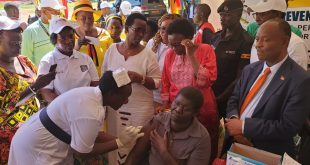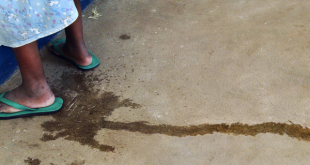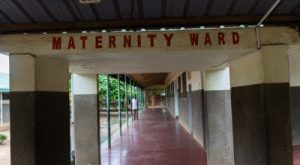
By Edward Akaki – Moroto, Karamoja
On a humanitarian ground, everyone deserves a right to life, health and clean water and sanitation, a
fact that thousands in Karamoja see as a myth due to changing climatic conditions.
The suffering and pain in Uganda’s north-eastern pastoralist region, is visible in massive crop failures as a
result of a long dry spells and flush floods. The scorched gardens and pasture mean limited or no food for both humans and their animals yet, cattle keeping provides main livelihood.
In addition, there is limited/no information available about climate change, no sensitization, people still believe in traditional rain tellers not knowing the situation has nowadays changed and they cannot predict right.
Understanding the climate of Karamoja
Unlike most parts of Uganda which has two rainy seasons, Karamoja has a single long rainy period between April and November. Rainfall peaks during April and May, with a break typically in June. Rains then return in July or August and continue through November.
Annual average rainfall ranges between 300 mm in the pastoral regions to 1200 mm in western areas of Abim and Nakapiripirit. Average annual temperatures range from 16°C in the highlands to 24°C in the rest of the region.
Whichever season it is in the region, there MUST be very serious climatic effects-Dry or Wet.

Food insecurity has remained as a major challenge in this region due to the ever harsh changing climatic conditions. During rainy seasons there tends to be flash floods which wash away the cultivated crops and also flood gardens leading to low crop productivity.
Worse still, when the dry spells arrives crop survival is very difficult as the soil dries up with little or no water at all to support planting or watering of crops. This therefore means the region produces less agricultural products to sustain its increasing population during either season.

Climate variability and change undermine the already limited resources and development in Karamoja through recurring droughts, flash floods and prolonged dry spells. High levels of variability in the climate cycle, including unpredictable rainfall patterns, already exist.
Moroto district as the district of focus of the study
The Karamoja sub region is covered by three types of livelihood zones, agro-ecological zones that run north to south and reflect different soils and rainfall patterns. Agricultural, Agro-pastoral and Pastoral zones are all experienced in
Karamoja.
Moroto lies in majorly the pastoral zones though just a bit lies on the agro-pastoral. Here, soils are predominantly sandy and of low on fertility. The lands have been overgrazed and shortage of pasture forces nomadic movements during the prolonged dry season, leading to competition for scarce resources and thus conflict.

Rainfall in this district is characteristically episodic, alternating with a prolonged severe dry season, and considerable variation arises from year to year. Cyclic droughts occur every two to three years. The episodic nature of these events means that most of the population is typically affected by a sequence of shocks that pose significant challenges to livelihood security.
Climatic effects on people living in Moroto
Insecurity
”Because of hunger, many of us were forced to go for raids as a way of getting food for our families. Most of the people have died because of raids in the names of fighting for the family and because we have no other means of survival with this harsh conditions of the climate”, Sagal Maruas a reformed warrior in Rupa Sub-county said.

He added that sometimes people are forced to survive on “Ngalam”, a wild fruit to push the days.
“The government has always provided us with some seeds for cultivation but they are not working because the plants dry off before we can harvest anything”, he concluded.
Mt. Moroto Regional Police spokesperson Michael Longole says climate change has highly affected cattle raids in the region according to the statistics they obtain from the field.
Longole says during dry season, the animals move faster and it is difficult to track the foot marks of animals thus enabling increased raids.
“Most times during this dry season when women go to the bush in search of firewood, these raids use the opportunity to rape them irrespective of the age which is very criminal”, he concluded
Crop production
The scorched gardens and pasture mean limited or no food for both humans and their animals. Yet, in this part of the region, cattle keeping provide the main livelihood.
Lojore Teresa a widow from Nadunget Sub-county say their efforts of cultivating goes to vain since either the flash floods wipe away all the crops or the sunshine dries up all the crops and in the end little or no harvest at all.
According to her, such disappointments have left most of the farmers frustrated and leading them to look for other ways for the survival of the families.
In addition, she says he children are now forced to eat food residues collected from town areas or even residue from the local brew called ‘marua’ as a means of survival in exchange for their charcoal or firewood brought to town centers.
Climate change creates numerous risks for agricultural productivity. For the Karamoja region, chief among these risks are increased temperatures and increased extreme weather events, such as intense single rainfall events and longer dry periods.
Much of Karamoja’s agricultural production is already vulnerable to changes in climate, which controls soil water availability, crop growth and productivity, and the incidence of agricultural pests. This situation is expected to be magnified in coming decades, and will be a major factor in agriculture sector productivity.
Livestock
Livestock rearing of sheep, goats and cattle has a long history in the Karamoja region, particularly in the pastoral and agro pastoral livelihood zones. Many Karimojong households obtain a proportion of their annual income from livestock.
Pasture management varies from north to south of Karamoja per climatic and soil conditions, and per the nature of relationships between tribes. For the pastoral tribe of Matheniko living in Moroto, they are greatly affected by inadequate water and pasture for their animals.
Lokiru Benedicto, a pastoralist living in Loputuk Sub-county thinks that as much as the government is building water reservoirs or dams, there is still too many aspects being handled in the wrong way since there is no sustainability of this water hubs.
According to the Food and Agriculture Organization (FAO), of the five factors that affect livestock performance, three of them which are rainfall quantity and distribution along with its effects on pastures, water availability and livestock diseases are linked to climate.
Climate change, in addition to factors such as poor rangeland management, constrains the number and type of livestock that Karamoja’s rangelands can support. The main impacts on the sector are increased unreliability of rainfall, increased length or intensity of dry periods, increased Carbon-dioxide and ozone concentrations, soil water stress among others.
Health
Climate issues in Karamoja center in large part on access to water. From a WASH perspective, the integrated disarmament and development report for the period 2011–2015 shows that 73 percent of the region’s population is located more than 30 minutes from a water source.
Daily water consumption per capita is lower than the average global standards of 15 liters per person per day across all districts except Abim. Lack of access to safe water contributes to malnutrition among all groups, as does a lack of basic sanitation practices such as hand washing especially among young children.
All of these issues are compounded by limited access to health services in the region. Use of improved sanitation facilities varies, with the highest rates (41 percent) in northern Karamoja and lower rates (11 percent) in the south, with the worst access rates in Moroto, Nakapiripirit and Napak.

Becky Faith Agilu, an In-charge at Lotirir health center II in Loputuk sub county , Moroto district explained that due to severe climatic change effects on the community, the facility always receive varying at records of diseases reported in the different seasons.
She however notes that in all the seasons, there is high level of malnutrition on children between the ages of 6months to 5years due to the hunger prevalence that runs across the year.
Child marriages
Karimojong parents still have a negative attitude towards educating the girl child claiming it’s a delaying process for them to reap from their girls forcing them to get married so that they can get money and livestock.
Mr Sagal Maruas, an elder, reformed warrior and a resident of Rupa Sub-county, acknowledged there was still rampant under-age marriages in the sub-region blaming it on the biting poverty in the region.
“Its poverty driving us to marry off our children but if our households were also stable like in other parts of the country, we would not be forcing children to get marriage,” he said.
On the same note, Lochoro Maria, a resident of Loputuk sub-county reiterated on how climate change has affected the communities and as well leading to child marriages.
She states that due to poverty the people are forced to engaged in activities that lead to climate change like charcoal burning and cutting down trees for firewood.
Interventions put in place
Ministry of Water and Environment.
According to the commissioner of the ministry Eng. Gilbert Kimanzi, there is a fully set up team in Moroto under the Moroto head office to unable easy access of services by the local community whenever needed, this is he says is to avoid being visiting workers in an area that is already having too many issues of water.

He added that, for over 30 years at the ministry their efforts to develop a sustainable plan for the Karamoja water crisis has been in vain but as well the team has not given up promising that surely a plan that can last years will soon be out.
Meanwhile the Permanent secretary, Mr. Alfred Okot Okidi has hinted that the new projects that are being launched in the Karamoja region most notably the Lopei dam will solve most issues in the region ranging from controlling flush floods, irrigation programs, animal watering among others expected from the multipurpose dams.
He however reiterated the government position on the biggest issue in Karamoja-water.
Okidi appealed to the local leaders to never give up on asking the government for their support when it comes to needs of the people.

The ministry of water and environment is currently working hand in hand with the Ministry of Agriculture on improving the water for production coverage in Moroto and Karamoja at large with many irrigation centered valley tank projects already at a go.
Community Based Organization
Kayese-community organization that was once called Karamoja Youth Effort to Support Environment is a local youth led organization that started in 2015 with voluntary works of greening Karamoja most especially Moroto and Napak districts.
Muya James Jemo, a project officer at organization says the organization is pre-dominantly focused on advocating for activities that would help improve the Climatic conditions in the region.
Among other activities carried out besides tree planting, is community awareness on the dangers of charcoal burning, tree cutting and deforestation providing options of survival to the community members like kitchen gardens and irrigation schemes in small scale fresh food growing.
Local Authority
John Robert Adupa Akiiki the LC3 chairperson Lotisan Sub county that is housing Kobebe dam which is harboring pastoralists from the different areas like Turkana, Matheniko, Pokot, Jie worries that the water level is depreciating at a high level and may not sustain another month if the drought continues.
He appealed to the government to improve on water resource facilities as a way of mitigating raids in the region citing that ever since the pastoralists settled from different areas together at Kobebe, there are no raids and people living peacefully and trading amongst themselves.
END.



